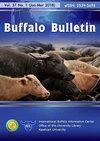安纳托利亚水牛卫生指数得分与产奶量的关系
IF 0.2
4区 农林科学
Q4 AGRICULTURE, DAIRY & ANIMAL SCIENCE
引用次数: 0
摘要
本研究旨在确定安纳托利亚水牛的卫生状况与产奶量之间的关系。以土耳其黑海中部两个养殖场饲养的50头挤奶水牛为研究材料。为了记录动物的卫生状况,使用1至4分(1=非常干净,2=干净,3=脏,4=非常脏)的量表评估动物身体的乳房和侧面卫生评分(UHS和FHS)。卫生指数得分(HIS)由60%UHS和40%FHS组成。为了消除环境因素,我们组成了两个产次(1次和≥2次)和哺乳期(SL1<100d和SL2≥100d)亚组。与其他亚组相比,第一次产次和第二次产次SL的水牛乳房更脏(P<0.05),而SL1的水牛产奶量更高。据估计,HIS与挤奶水牛试验日产奶量(TDMY)之间存在负相关和弱相关(r=-0.227)。建议使用更多的数据来确认这些关系,并将水牛保持在更卫生的环境中,这是有益的方法。本文章由计算机程序翻译,如有差异,请以英文原文为准。
Relations of hygiene index scores with milk production in Anatolian buffaloes
The aim of the study was to determine the relations of hygienic status and milk production of Anatolian buffaloes. Fifty milking buffaloes reared in two farms in the Middle Black Sea region of Turkey were used as the study material. To record hygienic status of the animals, udder and flank hygiene scores (UHS and FHS) of the animal’s bodies were evaluated using a scale with 1 to 4 points (1 = very clean, 2 = clean, 3 = dirty, 4 = very dirty). Hygiene index score (HIS) values were consisted of 60% UHS and 40% FHS. To eliminate environmental factors, two parity (1st and ≥2nd) and stage of lactation (SL1<100d and SL2≥100d) subgroups were constituted. The buffalo cows with first parity and later SL had more udder dirtiness (P<0.05) and, the buffalo cows those in SL1 had higher milk yield compared to the other subgroup. A negative and weak correlation (r = -0.227) was estimated between HIS and test day milk yield (TDMY) of milking buffaloes. Confirming these relationships using more data and keeping buffaloes within more hygiene is advised as beneficial approaches.
求助全文
通过发布文献求助,成功后即可免费获取论文全文。
去求助
来源期刊

Buffalo Bulletin
AGRICULTURE, DAIRY & ANIMAL SCIENCE-
CiteScore
0.50
自引率
0.00%
发文量
53
审稿时长
>12 weeks
期刊介绍:
Buffalo Bulletin is published quarterly in January-March, April-June, July-September and October-December. Contributions on any aspect of research or development, progress reports of projects and news on buffalo will be considered for publication in the bulletin.
 求助内容:
求助内容: 应助结果提醒方式:
应助结果提醒方式:


